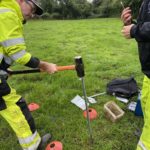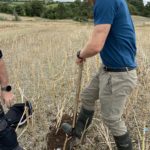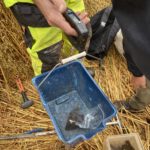Written by Charlotte Henrich.
Scale Ruler in Exchange for Lab Coats
The fact that we find ourselves in a climate emergency is undeniable and actions to combat this crisis are required. With “actions” probably most of us associate measures such as reducing plastic consumption or simply walking instead of driving. However, what many people might not be aware of is the pivotal role of farmers in the sector of agriculture. Cultivation, life stocks and dairy are indispensable to human life as they are the source of our staple foods. Yet, it is proven that these land practices also cause to release the carbon from the soils that has been stored for millions of years and consequently contribute to climate change. So, what now?

ARCZero – Accelerating Ruminant Carbon towards net zero Farming
I have been asking myself that question when I first heard about that issue not too long ago. When the opportunity opened up to getting actively involved in research within the NERC Research Experience Placement Scheme, I had no other choice but to apply for the ARCZero project! ARCZero – Accelerating Ruminant Carbon towards net zero Farming – supervised by Dr Paul Williams (Queen’s University Belfast) as well as Professor Nigel Scollan (Queen’s University Belfast), is independently led by Dr John Gilliland, alongside 6 further Northern Irish commercial farms and industry partners including Devenish. This European Innovation Partnership project seeks to measure and manage carbon flows at the individual farm level to empower farmers to make a positive change towards carbon zero farming.
Laboratory Experience
Coming from an architectural background, I have always been concerned about the environmental aspects within the built environment. To familiarize myself with these natural conditions, however, I decided to put aside my scale ruler, move away from the drawing board and get out. – Now, not quite so fast. As I started my placement, the project was already in full swing. During the first few weeks, my work was mainly laboratory focused – weekly Covid tests, lab coats and gloves. In the School of Biological Sciences at Queen’s, I started registering all the soil samples we had received from the farms into a database I developed. It was crucial to keep a record of all the samples as the plan is to build a soil archive for future references as well as teaching purposes. Consequently, I was processing the soils in a way that they could be archived securely and undergo further analyses. For this purpose, I was able to experience different laboratories and equipment, from Wet Lab to Teaching Lab, drying ovens, and sieves. We received new batches of samples from more farms on a weekly basis, whereas other samples were directly sent to NRM, a laboratory in England, to undergo specific carbon analysis. The more samples from different farms we received, the greater the variety of soils and their substance properties, which made it interesting to compare.

Fieldwork Experience
For a few days, I was given the opportunity to get out and experience the other side of the project. With the approval of my fieldwork risk assessment, I was able to join in on the sample taking. About an hour from Belfast’s city centre, we were working on an arable farm comprising several land categories such as woodland, grassland and pasture. I learned that the first round of samples has been taken earlier this year and exact GPS locations have been recorded at the specific randomized sites. Hence, this time we had to relocate those sites to take a sample from the same spot. Google Maps, Field-IDs with maps and a good orientation were crucial to do so. Essentially, three different kinds of samples were taken: 0-10cm, 0-30cm and bulk densities of a 10x10cm metal ring. Depending on the weather conditions, the coring had to be supported by sledgehammers if the ground was rather dry. Unfortunately for me, it was raining heavily on my first day in the field leaving me soaked from top to bottom after just five minutes and a full day ahead. This unprecedented Northern Irish weather challenged me, but it gave me a good insight of what it takes to do soil sampling. Especially with some fields being difficult to access, fence climbing, and conquering slopes were on the agenda. However, the actual soil sampling was done in a small area within the fields and the cores would be taken from nine different points within that area so that the soil would add up to weigh enough to undergo carbon analysis. Therefore, we checked their weights in situ and at each location, site-specific characteristics such as slope, type of soil and texture was noted for reference. A bulk density was only taken at some locations. Each day, we focused on another selection of fields, which were spread all over the area.
A Bridge between the Environmental Sciences and Architecture
As I was interested in what impact ARCZero might have on the built environment, specifically Architecture, I initiated conversations with Architecture staff at Queen’s. In fact, parts of the project ties in nicely with what is needed to inform a profound architectural design. From LiDAR imagery to carbon stocks and natural building materials as by-products to promote a circular economy – a potential future symbiosis between the two departments is not devious. I am certainly hoping that these conversations will be kept up and that I can implement these ideas into my future studies.

Furthermore, I had the pleasure to attend meetings between the Director of Agriculture and Sustainability at Devenish, Dr John Gilliland, Project leaders as well as Professor Nigel Scollan, Dr Paul Williams, and myself from Queen’s. These meetings were quintessential to keep everyone up to date and discuss the project’s progress, which I recorded and circulated in written meeting minutes. During the second half of my placement, we received the first few results from NRM’s carbon analysis. It was my task to take the data and develop a master spreadsheet, which will make it possible to compare the results easily. As I am aware that ARCZero will be presented at the COP26 in Glasgow, I am delighted that I had the opportunity to be a part of this project and to see that its impact not only on agricultural practices, but also on the built environment, will make a difference!





















































